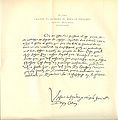File:John Calvin's Handwriting 01.jpg
“Or au pseaulme present, il est parlé de la noblesse et dignité de l’Eglise, laquelle doibt tellement ravir à soy et grans et petits, que tous les biens et honneurs de la terre ne les retiennent, ny empeschentqu’ils ne prétendent à ce but d’estre enroliez au peuple de Dieu. C’est grand chose d’estre Roy, mesme d’un tel pais; toutefois je ne doubte pas que vous n’estimiez sans comparaison mieux d’estre chrestien. C’est doncq un privilège inestimable que Dieu vous a faict. Sire, que vous soyez Roy chrestien, voire que vous luy serviez de lieutenant, pour ordonner et maintenir le royaulme de Jésus-Christ en Angleterre. Vostre tres hu[m]ble et obeissa[n]t serviteur Iehan Calvin.”
Jean Calvin, Lettres Françaises, 1854, Jules Bonnet, ed., Paris, Libbairie De. Ch. Meyrueis et Compagnie, vol. 1. pp. 346-347.
(French Letters, A. D. 1538 – 1554)
English:
"Now in the Psalm before us is set forth the grandeur and dignity of the church, which ought in such wise to draw over to itself both great and small, that all the riches and honours of the world cannot hold them back, nor keep them from aiming at this object, namely, to be enrolled among the people of God. It is a great thing to be a king, especially of such a country; yet I have no doubt but that you esteem it incomparably better to be a Christian. It is therefore an inestimable privilege that God has made you, sire, a Christian king, to the end that you may act as his vicegerent in maintaining the kingdom of Jesus Christ in England. Your very humble and obedient servant Iehan Calvin."
Original letters relative to the English reformation, written during the reigns of King Henry VIII, King Edward VI, and Queen Mary: chiefly from the archives of Zurich, Hastings Robinson, Parker Society (Great Britain), (1847), Cambridge, The University Press, vol. 2, pp. 714-715.
This volume forms the third series of the Zurich letters, and includes letters from 1531 to 1558.
Licensing
|
This work is in the public domain in its country of origin and other countries and areas where the copyright term is the author's life plus 100 years or fewer. This work is in the public domain in the United States because it was published (or registered with the U.S. Copyright Office) before January 1, 1930. | |
| This file has been identified as being free of known restrictions under copyright law, including all related and neighboring rights. | |
